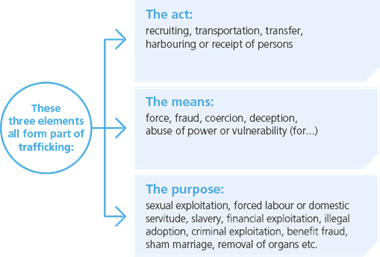Colchester Against Modern Slavery (CAMS)
Contents
Modern slavery within the UK
- 78% (13,290) were male and 21% (3,634) were female.
- 52% (8,854) of referrals were for potential victims who claimed exploitation as adults and 41% (7,019) claimed exploitation as children.
- For adult potential victims, labour exploitation was most reported 39% (3,433), whereas child potential victims were most often referred for criminal exploitation and county lines 43% (3,013).
Within Essex and Colchester, the most common types of modern slavery include county lines and forced criminal exploitation followed by labour exploitation and sexual exploitation.
Types of modern slavery
Modern slavery is an umbrella term for offences involved when one person obtains or holds another person in compelled service. The UK’s Modern Slavery Act identifies these crimes as holding a person in a position of slavery, servitude forced or compulsory labour, or trafficking through facilitating their travel with the intention of exploiting them.Slavery is when someone takes ownership of another person and often requires them to perform forced or compulsory labour. This usually restricts that person’s freedom of movement and exercises power over that person’s choices.
Human trafficking is when a person arranges or facilitates the travel of a woman, man or child with a view to that person being exploited. The movement could be across international borders, but it could also be within a country, from one city to another or even just a few streets. A person is a victim of human trafficking even if they haven’t yet been exploited but have been moved for the purposes of exploitation.
The United Nations defines Human Trafficking in the Palermo Protocol:
'Trafficking in persons shall mean the recruitment, transportation, transfer, harbouring or receipt of persons, by means of threat or use of force or other forms of coercion, of abduction, of fraud, of deception, of the abuse of power or of a position of vulnerability or of the giving or receiving of payments or benefits to achieve the consent of a person having control over another person, for the purpose of exploitation.'
Human trafficking = act + means + purpose

All three components must be present for an adult to be considered trafficked. The means does not need to be present for a child.
Servitude is similar to slavery, in that a person is under an obligation to provide a service which is imposed on them. An individual might live on a person’s premises, work for them and be unable to leave.
Forced or compulsory labour is ‘work or service which is exacted from any person under the menace of any penalty and for which the person has not offered himself voluntarily’ and has been found in a number of different industries including manufacturing, food processing, agriculture and hospitality.
The National Crime Agency highlights that within the UK there are several broad categories of exploitation linked to human trafficking, including:
- forced labour
- sexual exploitation
- domestic servitude
- organ harvesting
- child related crimes such as child sexual exploitation, forced begging, illegal drug cultivation, organised theft, related benefit frauds, etc.
- forced marriage and illegal adoption (if other constituent elements are present)
- forced to work through mental or physical threat
- owned or controlled by an 'employer', usually through mental or physical abuse or the threat of abuse
- dehumanised, treated as a commodity or bought and sold as ‘property’
- physically constrained or have restrictions placed on his/her freedom
[2]https://www.legislation.gov.uk/ukpga/2015/30/pdfs/ukpga_20150030_en.pdf
[3]https://www.equalityhumanrights.com/en
[4]https://www.osce.org/odihr/19223 (United Nations’ Protocol to prevent, suppress and punish trafficking in persons (2000)
[5]Diagram from The Human Trafficking Foundation: https://www.humantraffickingfoundation.org/theissue
[6]https://www.nationalcrimeagency.gov.uk/what-we-do/crime-threats/modern-slavery-and-human-trafficking
[7]https://www.unseenuk.org/about-modern-slavery/
Page last reviewed: 19 September 2023

